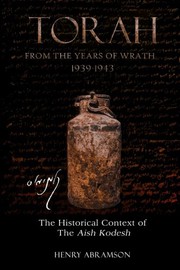- Summary
- Discovered in the rubble of the Warsaw Ghetto, Rabbi Kalonymus Kalmish Shapira's wartime writings exemplify the faith of Hasidic Jewry under the unimaginable conditions of the Nazi occupation. Published in 1960 under the Hebrew title Aish Kodesh, the notes of Rabbi Shapira's weekly Sabbath sermons and annotations have been studied by pious Hasidim and secular academics alike, seeking his answers to the searing theological questions posed by the war. Why do the righteous suffer? Where was God during the Holocaust? Torah from the Years of Wrath provides a new and essential scholarly contribution by placing Rabbi Shapira's writings in their immediate historical context. Using a wide variety of primary sources, Abramson situates the sermons within the daily experience of Jews in the Warsaw Ghetto, demonstrating that Rabbi Shapira's often enigmatic discourses contained veiled messages--opaque to later readers, but readily understood by his congregants at the time--that related directly to the traumatic events endured by his Hasidim. Abramson's reconstruction of the micro-history of the Ghetto reveals that Rabbi Shapira's work represents a sustained act of spiritual heroism, helping his followers place their individual tragedies within the cosmic meta-history of the Jewish people, as expressed in the Torah itself. Torah from the Years of Wrath provides a new and essential scholarly contribution by placing Rabbi Shapira's writings in their immediate historical context. Using a wide variety of primary sources in Yiddish, Hebrew, Polish and German, Abramson situates the sermons within the daily experience of Jews in the Warsaw Ghetto, demonstrating that Rabbi Shapira's often enigmatic discourses contained veiled messages--opaque to later readers, but readily understood by his congregants at the time--that related directly to the traumatic events endured by his Hasidim. Abramson's reconstruction of the micro-history of the Ghetto reveals that Rabbi Shapira's work represents a sustained act of spiritual heroism, helping his followers place their individual tragedies within the cosmic meta-history of the Jewish people, as expressed in the Torah itself. "Extraordinary." Rabbi Moshe Weinberger "A groundbreaking study, a great achievement and a major contribution." Dr. Daniel Reiser
- Format
- Book
- Author/Creator
- Abramson, Henry, author.
- Published
- [North Charleston, South Carolina] : [CreateSpace Independent Publishing Platform], 2017
- Locale
- Poland
Warsaw
Warsaw (Poland)
- Edition
- CreateSpace edition
- Notes
-
Includes bibliographical references.




